Classical Music on Stamps
A weekly feature
presented by David Barker
1. The first stamps to feature composers
As far as I can tell, the first country to put a composer on its stamps
was Austria. Given its musical heritage, that is probably not
surprising. In April 1922 the new Republic of Austria released a set of
stamps featuring seven of its greatest composers: Haydn,
Mozart, Beethoven, Schubert, Bruckner, Strauss Jnr and Wolf. The latter is perhaps the most surprising inclusion (with apologies to Hugo
Wolf aficionados).
They were produced in print runs of around 500,000 and only available
for a month. This may seem a quite large number, but this was in an era
when the more common stamps were produced in tens of millions.
Nonetheless, the set is not especially valuable: Stanley Gibbons gives a
price of £34 for a mint set, and £70 for a used one - clearly they found
their way into collector's albums more frequently than onto letters.
These stamps are known as charity stamps, where the
normal postage cost was augmented by an extra charge used to raise money
for various causes. This was common in a number of countries, such as
France, Germany, Finland, Switzerland and New Zealand. These particular
stamps were sold for ten times the value shown, the funds raised used
for supporting needy musicians. What makes them unusual philatelically
is that the charity amount is not shown on the stamp, only the amount of
postage. For example, the Haydn sold for 25 kronen, 2½ of which was the
postage, the balance for the charity.
You will see the more usual approach, where both postage and charity
charges are shown, in future issues of this series.
While I don't intend to make this a column discussing
the artistic and aesthetic merits of stamps, I think these are quite
beautiful by any criteria. The designer used classic portraits
for the four older composers, and photographs for the other three.
2. Claude Debussy on stamps
Debussy is probably the biggest name in classical music to have an
anniversary in 2018, that being the hundredth anniversary of his death, so it
seems appropriate to see how he has been celebrated in the past on
stamps. Not widely it would seem, as there are only eight stamps in total to
feature him or his music. This compares with more than 200 for Mozart,
and forty-plus for Haydn.
The first two come from France - not a surprise - and date from 1939
and 1940, using the same design, that of a faun surveying a pastoral
scene; in the afternoon, one assumes.
As with the Austrian ones from last week, these are charity stamps,
and this time, the prices for both postage and charity (10c) are shown.
The charity this time? Unemployed intellectuals! It is surprising that
they comprise the only two French stamps to have a connection with
Debussy - his birth centenary in 1962 went by without a mention. It will
be interesting to see if a Debussy stamp appears from La Poste this
year.
The 150th anniversary of his birth in 2012 was commemorated by two
countries: Monaco, so at least a French connection there, and also by
Bulgaria, rather less obviously.
This was in fact the second Debussy-related stamp from Monaco, there having been
one ten years earlier, which celebrated the 100th anniversary of the
premiere of his opera Pelléas et Mélisande. In case you are
wondering, as I was, there was no Monaco connection with the opera's
first performance, which was in Paris. The portrait of Debussy used is based on an 1884 portrait by Marcel Baschet.
In 1993, the opening of Finland's new opera house was celebrated in a
series of four stamps picturing operas and ballets performed there.
Debussy's Prélude à l'après-midi d'un faune was used for a
ballet, and a visually striking photograph of the action was used for
the stamp.
That leaves us with two final contributions, neither of which seem to
have any connection to Debussy dates or significant performances. In
1967, the African country Togo celebrated the 20th anniversary of UNESCO
with a stamp whose main feature was that of the best known portrait of
Debussy. If someone is able to link this organisation with the composer,
I'd love to hear it; I'm fairly sure that he has no connection to the
country.
Finally, in 1980, Paraguay released a set of nine stamps featuring
paintings of ballerinas and small images of composers, Debussy being
one. Whilst it is true that Debussy did compose music for a number of
ballets, this would seem to not really have been an important aspect in
the choices made by the stamps' designer. Firstly, Tchaikovsky is
notable by his absence from the set, and the presence of Bach, Chopin
and Beethoven is rather curious to say the least.
3. Schumann's death centenary
In July 1956, both West and East Germany released stamps
commemorating the 100th anniversary of the death of Robert Schumann,
each bearing a likeness of the composer and some bars of music. Stamps
such as these, which mark a particular event or similar, are known as
commemoratives.
In the case of West Germany, it was a single stamp with a cameo of
Schumann; it is not recorded anywhere I can find what the music is.
East Germany opted for two releases, released ten days apart for no
obvious reason, using the same design - a famous portrait in front of a
score - in different colours for the different denominations.
Unfortunately, there was a "slight" problem: the admirable detail in
the score revealed that the designer had somehow managed to use music by
Schubert, his Wanderers Nachtlied. So a new design, bearing Schumann's Mondnacht,
was released in October.
Did this make the error stamps more valuable? Surprisingly no. Both
releases had the same print runs - 1 million for the 10 and 5 million
for the 20 - and the prices shown in Stanley Gibbons indicate that it is
the correct designs that are worth more, albeit not much. For example,
the less common 10 pfennig is valued at £3.25 for the incorrect and
£7.50 for the correct issue (in mint condition).
4. The most unlikely stamps #1
I remarked two weeks ago in the Debussy column about two of the
stamps being rather surprising in their content and also because of the countries
which had issued them. That has prompted me to have an occasional entry
in this series on stamps from unlikely sources or on unlikely topics.
Today's is the first nomination, and I suggest that it may be quite hard
to beat.
In doing research for last week's topic on Robert Schumann, I found
a set of three stamps featuring a much less well-known Schumann: Georg (1866-1952), also from
Germany and no relation. He is not entirely unknown as a composer - the CPO label has
released five CDs of his music in the last few years - so it would not
have been a total surprise had Germany decided to issue stamps in 2016 to
commemorate the 150th anniversary of his birth. However, the reason that
they appear
here under the heading of "unlikely" is because the issuing country was the
African nation of Djibouti!
There were a number of Djibouti releases in 2016 celebrating the life
and works of famous people, namely Wolfgang Mozart, Pablo Picasso,
Claude Monet, Robert Baden-Powell, Princess Diana, Marilyn Monroe, Elvis
Presley and Walt Disney. Georg Schumann does seem to be a rather
unlikely inclusion in this list of luminaries.
5. British stamps
The UK was, of course, the originator of government-issued stamps with
the Penny Blacks of 1840, and even had a head of state for 25 years
obsessed by stamps: George V. However, it would seem that the
commissioning body for stamp designs had little interest in classical
music, because it was not until 1972 that any British stamp with that
theme. This first stamp commemorated the 100th anniversary
of the birth of Ralph Vaughan Williams, in a set with three other (non-musical)
anniversaries.
In 1980, we have a series celebrating four famous British conductors,
and while three of them - Sir Henry Wood, Sir Thomas Beecham and Sir
John Barbirolli - would have made just about everyone's shortlist, I
suspect quite a few of you might have opted for Sir Adrian Boult ahead
of Sir Malcolm Sargeant.
In 1984, to commemorate the 50th anniversary of the British Council,
a set of four stamps was issued, depicting different aspects of its
work. One "Promoting the arts" depicts a violinist, some music and the
Parthenon.
It is not until 1985 that Sir Edward Elgar receives a philatelic
mention, in a beautifully and unusually designed series which uses art
to portray four famous British works, Handel's Water Music, Holst's
Planets, Delius' The First Cuckoo of Spring and Elgar's Sea Pictures.
The set was
released as part of the European Year of Music.
Notice anything unusual about the Elgar stamp? He is named plain
"Edward Elgar", whereas the four conductor knights have been given their
title.
The 150th anniversary of the birth of Sir Arthur Sullivan in 1992 was
celebrated with a set of five stamps, with colourful images depicting
five of the most famous G&S operettas.
The remaining two to this point - were issued in 2009 and
2013, using a common design, to commemorate birth anniversaries for
great names who had previously been absent from British stamps: Henry
Purcell and Benjamin Britten.
So, after a slow start, 17 stamps with a classical theme isn't too
bad, though it should be noted that the number of issues featuring
either The Beatles or David Bowie is also 17.
6. Bach, Handel & Schütz anniversaries - Germany
I'm sure you are all aware that Bach and Handel were born in the same
year (1685), and many would also know that Heinrich Schütz was born 100
years before. This meant that 1985 saw the release of numerous stamps
from around the world celebrating the 300th anniversary for Bach and
Handel, and a small number for Schütz's 400th. In Germany, we can go
back 50 years earlier, for the 250/350th anniversaries.
In 1985, there were, of course, two Germanies, and both released
anniversary stamps, though West Germany did not honour Schütz, just Bach
and Handel. The designers from both countries used the same portraits,
but while West Germany went with the simple option of using the
paintings unaltered, the East Germans used sketch reproductions. Handel
seems to have faired rather better, losing some weight in the process,
while Bach has gone from benign in the painting to something rather more
angry in the sketch.
7. Bach, Handel & Schütz anniversaries - world
Last week, I looked at the celebration of the shared anniversary
years for these composers in their native land of Germany. In 1985,
quite a
number of other countries also commemorated their birth anniversaries on
stamps. It should be noted that 1985 was also the International and
European Year of
Music, which meant that the "limelight" was often shared with other
composers without significant anniversaries in the year; for example, in
Great Britain, where Elgar, Delius and Holst were also included in a set
with Handel (see Article 4 below).
Of these countries, Hungary seems to be the most obvious one in terms of its classical
musical heritage, though Ireland does of course have the Handelian
connection through Messiah. Hungary's set for the International Year also included Cherubini,
Chopin, Mahler and Ferenc Erkel, while Ireland had Domenico Scarlatti,
appropriate since he also was born in 1685.
India and Monaco
celebrated Bach and Handel's tercentenary with stamps showing both men.
Three other countries, all rather unlikely, issued stamps for both
Bach and Handel: (the Islamic Republic of) Mauritania, the Turkish
sector of Cyprus and the Turks and Caicos Islands, the latter really
splurging with four stamps for each composer (I have only shown two).
Heinrich Schütz's anniversary was commemorated by only one country
outside the two Germanys - Guinea-Bissau - which also included Handel,
but not Bach, in its set of composers for the International Year.
Finally, seven more countries issued stamps for Bach alone: Albania, the Republic of Congo, Dominica, Grenada, Mexico, Poland and the USSR.
If you are struggling to find the Albania stamp(s), they are the two
inscribed RPS E Shqiperise; the blue one apparently depicts Eisenach.
8. Orchestra Anniversaries - Part 1
It is not just composers who feature on commemorative stamps
celebrating a particular anniversary, but also some of the orchestras
they wrote for. There are a significant number of stamps in this
category, too many for one week's column.
Let's begin with the first orchestra-related stamps, a set of six issued by
Romania in 1946 to celebrate the 25th birthday of the Bucharest
Philharmonic. I have shown only the three different designs, as the XXV
design featured on three in different colours and denominations, and
similarly the Athenaeum (concert hall) appears on two. The profile
appearing on the third is that of Romania's greatest composer, George
Enescu.
I will stay in eastern Europe for the rest of this week's column. Czechoslovakia, and the two independent
nations it became after the fall of Communism, have been
prolific in terms of classical music on stamps. The Czech
Philharmonic Orchestra has had three anniversaries commemorated on
stamps: its 70th (in 1966), 90th and 100th.
The Slovak RSO had its 50th anniversary in 1979, and the Slovak
Philharmonic its 50th in 1999.
Finally, three more former Iron Curtain countries commemorated
orchestras in the last two decades: the Warsaw Philharmonic's 100th
(2001), the Pannon Philharmonic (formerly known as the Pécs SO)
its 200th (2011) and perhaps most fittingly, given the form of
commemoration, the 80th anniversary of the Post Office Brass Band of
Slovenia also in 2011.
Next time, I will look at orchestra stamps from other countries, but
very surprisingly, four that will not receive a visit are France, Germany, Russia
and the United Kingdom, as they have not elected to celebrate their very famous
orchestras philatelically.
9. Orchestra Anniversaries - Part 2
To continue from last week's topic, let's go to Vienna and its two
orchestras, the Philharmonic and the Symphony. Each
has received its due recognition on Austrian stamps, more than once in each case:
the VPO for its 125th (in 1967), 150th and 175th anniversaries, and the
VSO its 75th (1975) and 100th.
I found just two other stamps celebrating the anniversaries of
European orchestras: the Royal Concertgebouw (100th, 1988) and the
Luxembourg Philharmonic (75th, 2008).
To finish this topic, there are stamps from Argentina (Buenos Aires
City Symphony, 100th in 2010), Canada (Montreal SO: 50th in 1984, &
Quebec SO: 100th in 2002), Israel (Israel PO: 25th, 1961 & 75th) and
Mexico (State SO, 45th in 2016).
10. "Fantasia" in Liechtenstein
Before Disney's lawyers get busy, let me say that the designers of
the 2006 set of
eight stamps that is the subject of this week's column have not impinged
on the intellectual property of the 1940 classic animated film. It's just what the combination of
cartoon-style artwork and famous classical pieces brought to mind for
me. The stamps illustrate, in delightful whimsy, eight works, one of
which does happen to be in common with the film (the
Beethoven Pastoral). No more words are needed - please click on the
images to get larger versions to better enjoy them.
 |
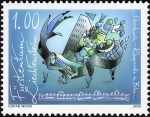 |
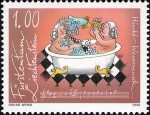 |
 |
| Pastoral Symphony |
Rhapsody in Blue |
Water Music |
Midsummer Night's Dream |
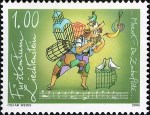 |
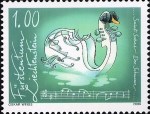 |
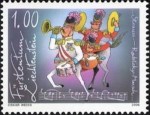 |
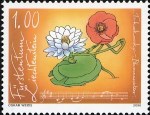 |
| The Magic Flute |
The Swan |
Radetzky March |
Waltz of the Flowers |
<<< Newest entries ~
Entries 11-20 ~
Entries 21-30 ~
Entries 31-40
